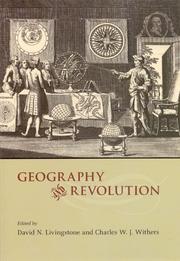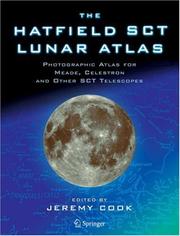| Listing 1 - 2 of 2 |
Sort by
|

ISBN: 1282738453 9786612738456 0226487350 9780226487359 9780226487335 0226487334 0226487334 Year: 2005 Publisher: Chicago : University of Chicago Press,
Abstract | Keywords | Export | Availability | Bookmark
 Loading...
Loading...Choose an application
- Reference Manager
- EndNote
- RefWorks (Direct export to RefWorks)
A term with myriad associations, revolution is commonly understood in its intellectual, historical, and sociopolitical contexts. Until now, almost no attention has been paid to revolution and questions of geography. Geography and Revolution examines the ways that place and space matter in a variety of revolutionary situations. David N. Livingstone and Charles W. J. Withers assemble a set of essays that are themselves revolutionary in uncovering not only the geography of revolutions but the role of geography in revolutions. Here, scientific revolutions-Copernican, Newtonian, and Darwinian-ordinarily thought of as placeless, are revealed to be rooted in specific sites and spaces. Technical revolutions-the advent of print, time-keeping, and photography-emerge as inventions that transformed the world's order without homogenizing it. Political revolutions-in France, England, Germany, and the United States-are notable for their debates on the nature of political institutions and national identity. Gathering insight from geographers, historians, and historians of science, Geography and Revolution is an invitation to take the where as seriously as the who and the when in examining the nature, shape, and location of revolutions.
Geography --- Science --- Discoveries in science. --- Revolutions --- Philosophy. --- revolution, rebellion, insurrection, social change, politics, activism, unrest, geography, place, space, science, darwin, newton, copernicus, printing press, time keeping, photography, technology, invention, united states, germany, england, france, national identity, political institutions, history, discovery, wallace, maps, mapmaking, cartography, cape of good hope, clocks, empire, edme mentelle, alexander von humboldt, nonfiction, innovation.

ISBN: 1280461918 9786610461912 1846282365 1852337494 1849969035 Year: 2005 Publisher: London : Springer,
Abstract | Keywords | Export | Availability | Bookmark
 Loading...
Loading...Choose an application
- Reference Manager
- EndNote
- RefWorks (Direct export to RefWorks)
SCT and Maksutov telescopes - which of course includes the best-selling models from Meade, Celestron, and other important manufacturers - reverse the visual image left for right, giving a "mirror image". This makes it extremely difficult to identify lunar features at the eyepiece of one of these instruments using conventional atlases, which show the Moon "upside-down" with south at the top. This new SCT version of Hatfield's famous lunar atlas solves the problem. Photographs and key maps in the Hatfield SCT Lunar Atlas are exactly as the Moon appears through the eyepiece of an SCT or Maksutov telescope. Smaller IAU-standard reference photographs are included on each page, to make it simple to compare the mirrored SCT photographs and maps with those that appear in other atlases. This edition uses the superb original photographs taken by Commander Henry Hatfield using his purpose-built 12-inch reflector. The key maps, on which lunar features can be readily identified, retain the style and clarity that made the original justly famous.
Lunar geology. --- Moon --- Earth (Planet) --- Satellite --- Astrogeology --- Astronomy. --- Popular Science in Astronomy. --- Astronomy, Observations and Techniques. --- Observations, Astronomical. --- Astronomy—Observations. --- Astronomical observations --- Observations, Astronomical --- SCIENCE / Space Science / Astronomy. --- JUVENILE NONFICTION / Science & Nature / Astronomy. --- Astronomy, Observations and Techniques --- Planetology. --- Lunar craters --- Telescopes --- Astronomy --- Observations. --- Astronomical telescopes --- Optical telescopes --- Telescope --- Astronomical instruments --- Optical instruments --- Craters, Lunar --- Impact craters, Lunar --- Lunar impact craters --- Moon craters --- Impact craters --- Planetary sciences --- Planetology
| Listing 1 - 2 of 2 |
Sort by
|

 Search
Search Feedback
Feedback About UniCat
About UniCat  Help
Help News
News